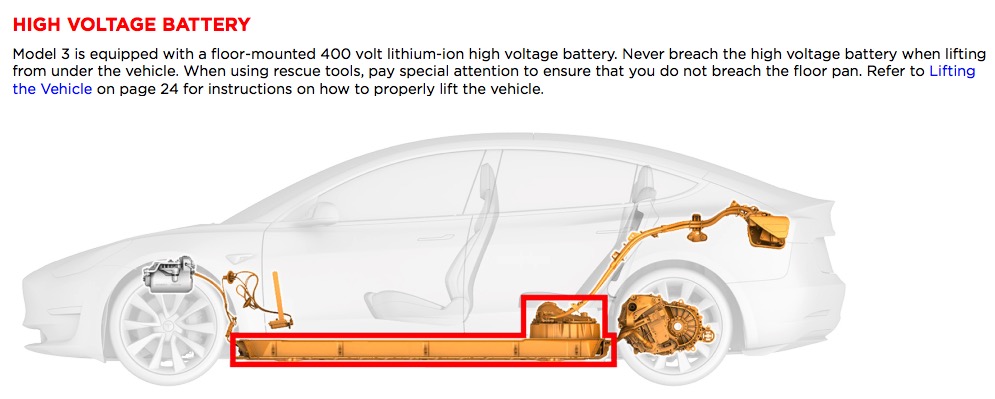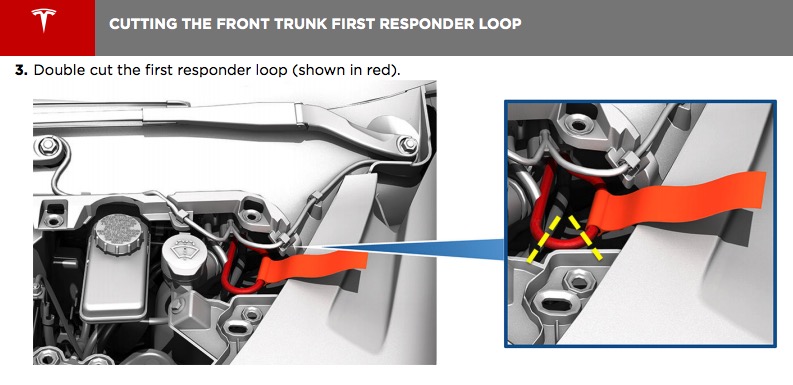Electric vehicles with lithium-ion batteries present a complex and hazardous situation for firefighters responding to a vehicle accident. If a conventional vehicle with gasoline or diesel catches fire after an accident it usually happens quickly and is very evident. When batteries in an electric car are damaged by debris on the road or a collision, a short circuit can occur in one or more of the thousands of cells, creating heat which may ignite the chemicals inside the battery. This can spread to the adjoining cells and lead to the condition known as “thermal runaway” in which the fire escalates.
Independent research and information for first responders produced by Tesla warn that a battery fire in an electric vehicle can take 3,000 gallons of water and up to 24 hours to fully suppress. Firefighters should immediately arrange for water tenders and use a master stream if possible. Consider allowing the battery to burn while protecting exposures. Breathing apparatus is absolutely required. In some cases firefighters have run out of air and had to get a second bottle.

If the fire appears to be out, a thermal imaging camera can help to identify any areas still burning or overheated. In one test a battery reignited the vehicle 22 hours later. Tesla recommends that after a fire their vehicles should be stored at least 50 feet away from any combustible material.
Their new Model 3 has two “cut loops” that firefighters can sever to shut down the high voltage system outside of the high voltage battery and disable the supplemental restraint system and airbag components.

Thanks and a tip of the hat go out to Bean.
Typos or errors, report them HERE.

The link to the Tesla source material explains: The 3,000 gallons of water is to cool the battery.
Bill Gabbert: I guess my question is what do they with the 3,000 gallons of contaminated water? Is there an EPA exemption of some kind for waste water for Fire Fighting events? Has to be there are a lot more toxic chemicals washed out of industrial fires.
Water and LI batts don’t mix. Cooling compromised batts with water seems like a pretty risky strategy. And an excellent point Mr.Gabbert…what does get done with the 3k gal of water assuming it wasn’t evaporated when said batteries explode?
The confusion is worsened by lumping lithium (non rechargeable) with lithium ion (rechargeable) batteries. Lithium batteries will explode when water is used! Lithium ion batteries contain an insignificant percentage of lithium and water is the BEST way to cool a thermal incident.
gerry from LithSafe
3000 gallons of What to extinguish? Im aware water is not an option…
Beware, you ought to update your article.
The batteries can be more dangerous than you presented. Reportedly the Tesla that crashed in Mountain View California killing the occupant from burns and other injuries. The battery reignited several times over six days. So it is unknown how long, it takes for them to really be safe. Tesla also falsely claimed that these batteries were landfill safe. Imagine what could’ve happened if this battery was buried and reignited a few days later. It could have set a landfill on fire and been a toxic environmental hazard. Beware the fumes can also be toxic and can contain heavy metals. Even the coolant can be flammable and explode. The Tesla that crashed recently in Fort Lauderdale Florida was reportedly on fire before it came to a rest, despite previous assurances that Tesla battery fires have a delayed slow start. The Tesla crash in Fort Lauderdale Florida had a fire that started so quick and the fire was so intense that two occupants burned to death and would be rescuers could not get to them. In Tesla’s are emergency responders guide it recommends that emergency responders should wear full protective gear and self-contained breathing apparatus. Tesla batteries can have flash fires, explosions and go off like Roman candles.